 This information has been archived for reference or research purposes.
This information has been archived for reference or research purposes.
Archived Content
Information identified as archived on the Web is for reference, research or recordkeeping purposes. It has not been altered or updated after the date of archiving. Web pages that are archived on the Web are not subject to the Government of Canada Web Standards. As per the Communications Policy of the Government of Canada, you can request alternate formats on the "Contact Us" page.
Canadian Forces Transition
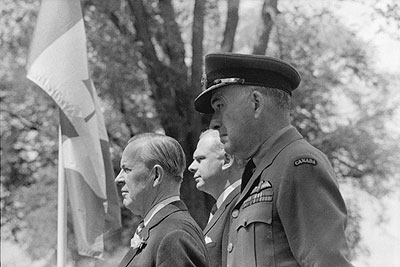
Library and Archives Canada/Duncan Cameron/PA-117109
Left to Right, Prime Minister Lester B. Pearson, Minister of National Defence Paul Hellyer, and Air Chief Marshal Frank Miller, June 1965.
Hellyer’s Ghosts: Unification Of The Canadian Forces Is 40 Years Old – Part One
by Major-General Daniel Gosselin, CMM, CD1
For more information on accessing this file, please visit our help page.
Following the most careful and thoughtful consideration, the government has decided that there is only one adequate solution. It is the integration of the Armed Forces of Canada under a single Chief of the Defence Staff. This will be the first step toward a single unified defence force for Canada. The integrated control of all aspects of planning and operations should not only produce a more effective and co-ordinated posture for Canada, but should also result in considerable savings.2
White Paper on Defence, March 1964
Introduction
On 1 February 1968, one of the most important events of Canada’s military history took place when the law that eliminated the Royal Canadian Navy, the Royal Canadian Air Force and the Canadian Army went into effect, and the three proud military services ceased to exist. Unification of the three services into one, the Canadian Armed Forces, turned 40 years old this year. Since then, various dominant and, at times, competing concepts have influenced and shaped the evolution of the Canadian Forces (CF) as an institution, but none of those has had a more dramatic impact and long-lasting effect than the ideas that the Liberal Government of Lester B. Pearson and his strong-minded and ambitious Minister of National Defence, Paul T. Hellyer, brought into defence in the spring of 1963.
The Canadian Forces Reorganization Act (Bill C-243, informally referred to as the “unification act”) was the government’s legislation that amended the National Defence Act to eliminate the three services and create one unified military force. But it was the fundamental – and innovative – ideas that Hellyer championed during his three-and-a-half years as minister, and the contentious reforms that he pushed through the defence establishment, that radically changed Canada’s military, generating in their wake much discord and controversy. Hellyer’s ideas were influential in many respects, and planted the seeds for more reforms in the 1970s and 1980s. As defence analyst Douglas Bland, author of two important studies that touched on unification and its consequences, stated, “[t]he policy ... caused an immediate and prolonged public argument and great dissatisfaction within the armed forces.”3 It was also the genesis for one of the most divisive crises of civil-military relations in Canada.4
This article, presented in two consecutive parts, explores the fundamental ideas that led Minister Hellyer to unify the CF and that underlined the integration and unification efforts of the 1960s,5 and it assesses the legacy of those core concepts in 2008.6 Hellyer’s ideas first came to light with the Liberal Government’s 1964 White Paper on Defence, which contained several original concepts, and set out the basic philosophy and rationale for the unification of the armed forces. Bill C-243 and Bill C-90, an act that created the office of the Chief of the Defence Staff (CDS) and that resulted in the formation of a single integrated defence staff at a renamed Canadian Forces Headquarters (CFHQ), were both aimed at legally implementing the policy decision of the White Paper of 1964. Hellyer’s addresses to Parliament in May 1964 on Bill C-90, and in December 1966 on the Canadian Forces Reorganization Act, expanded considerably on the ideas elaborated in the White Paper, especially in articulating the benefits for Canada of a unified CF command structure.7 Taken together, these policy statements enunciated Hellyer’s ideas and provided the intellectual foundation for a deep-seated restructuring of Canadian defence – one that has exerted pressure on the institution for 40 years.
Five major unification themes, capturing the core ideas of Hellyer’s integration and unification strategy, are reviewed and assessed in turn in this article. The first two themes will be presented in this first part, while the next three and a concluding segment will appear in part two in the next edition. These major themes are: (1) the need for a single coherent defence policy for Canada; (2) the creation of the office of the Chief of the Defence Staff (CDS) to centralize and strengthen the administration and control of defence policy and of the CF; (3) the creation of a unified system of command complete with the reorganization of the field commands; (4) the introduction of modern management methods and the elimination of triplicate functions to achieve efficiencies; and, (5) the achievement of a single higher loyalty to the CF. While Hellyer likely never considered those major unification themes as distinct, but rather as a complete and integrated set of reforms necessary to radically transform Canadian defence, examining them individually allows for a better assessment of those principal ideas of the 1960s and of their legacy in 2008, and provides an understanding of the evolution and the basis for organization and decision-making within the CF.
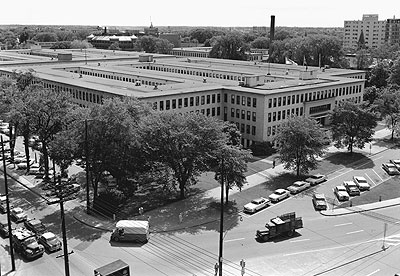
DND photo 698-IMG0076
Canadian Forces Headquarters, Cartier Square, Ottawa, March 1964.
Hellyer brought in several progressive and innovative ideas at Defence in 1963, but with unification he also tried to impose a dogmatic and idealistic vision of what the CF should look like and how it should be organized. As events proved out, wholesale unification for the CF was too one-dimensional as an organization model to impose on the institution, and not viable in the long term. During the past three-and-a-half years, under the leadership of General Rick Hillier as CDS, the CF has undergone an important renewal, unseen in decades. Fuelled in large part by Hillier’s bold vision of a new role for the CF as part of Canada’s international policy, a serious commitment by two successive governments to re-invest in defence and rebuild the CF, along with a demanding combat engagement in southern Afghanistan, Canada’s military has transformed significantly in recent years. Still, as this article will demonstrate, some of the ideas that inspired Hellyer in the 1960s have endured after over 40 years, and even flourished in recent years, while others have finally been buried – perhaps for good. For sure, if there were any of Hellyer’s “unification ghosts” left in 2005 when Hillier arrived as CDS, it is fair to state that those have since been exorcised.
One Unified Defence Policy for Canada
Much has been made over the years of Hellyer’s reforms to reorganize the Canadian military, and thus it is easy to forget that, in the controversy that unification generated, the central idea of the 1964 White Paper on Defence was to develop a defence policy based on Canadian needs and national interests. By the time Hellyer arrived at Defence in 1963, the three services were the dominant players in the development of defence policy,8 a reality strongly reinforced by the Canadian military “growing up allied,” and Canada’s continental and international commitments to the North American Air Defence Command (NORAD) and to the North Atlantic Treaty Organization (NATO).9 The service-oriented commitments tended to steer Defence away from further integration, and encouraged the development of individual service capability, force structure and war planning, to the detriment of a true national defence strategy.10 As the three services continued to focus and specialize on their distinct missions, they remained isolated from each other, contributing even more to a segmented and inflexible defence policy.11
The lack of coordination at the top of the defence structure and the “... seemingly haphazard determination of priorities” also exercised a profound influence on Hellyer, which led him to write the White Paper himself.12 The government defence policy paper outlined most of the concepts that would serve as guideposts to steer Hellyer throughout his tenure as minister. In it, the minister reviewed the international outlook and the “range of potential conflict” Canada could engage in, concluding that Canada needed more flexible forces to meet the future challenges. Hellyer certainly did not dismiss collective security and active participation in Canada’s alliance commitments, but he envisaged a future with more complex peacekeeping operations and wanted “the majority” of the forces in Canada available for deployment.13 To him, the solution was to change radically the disposition of the armed forces to produce more mobile and more integrated capabilities to respond to new commitments, including an intervention force capable of operating anywhere.14
As Bland noted, however, “[t]his strategy, of course, could not be accomplished without changing defence commitments and the basic structure of the armed services.”15 With the concept of unification, Hellyer sought a military establishment that would cease to continually resolve problems and develop policies from a service perspective. Only a single unified command structure supported by a more robust integrated joint staff to control all aspects of planning and operations, topped by a new Defence Council chaired by the minister, could think and act from a national perspective, and formulate unified national solutions to Canadian defence problems, Hellyer reasoned.16 The second part of the White Paper therefore addressed his ideas for the reorganization of the defence structure to meet this objective.
Unfortunately, the establishment in 1968 of a single unified service in Canada, even when bolstered by the creation of a single national defence headquarters four years later, did not eliminate the conflicting loyalties. It did not achieve the effect Hellyer sought with his restructuring, and it has not prevented the traditional “strong-service idea,” focused on the preservation of the army, navy and air force as separate institutions, to continue to exert strong dissenting pressure on the institution.17 The absence of political and military leadership, and the lack of policy direction in the 1970s and 1980s, combined with the continuation of service- oriented alliance commitments and participation to United Nations peacekeeping operations, only further reinforced service planning and force development, and perpetuated the conditions for the three services to continue to think and operate independently and to compete over roles and missions.18
Without a coherent national policy framework and a single strategy, the ideals of unification were left to flounder over the years, with the strong-service idea fostering “...a bias against planning from a national perspective.”19 To make matters worse, as Bland noted in 1995, defence policy in Canada over those years seldom originated from a strategic idea – a notion Hellyer had attempted to introduce in 1964 – but, rather, it evolved from the dynamics of the annual federal budget.20 Deep and consecutive budgetary reductions in the 1990s, along with pressure from powerful interest groups to steer the armed forces away from combat capabilities, also triggered strong institutional reflexes for service survival.21 Without a national defence strategy or a coherent unified defence policy, a de facto policy of maintaining a “balanced force” came to dominate thinking inside Defence, the argument being that the maintenance of certain minimal key fighting capabilities within each service was good for Canada, sustaining a bottom-up service-oriented approach to defence planning and force development.22 However, this started to change in the years after the 9/11 attacks with General Raymond Henault as CDS, and, more dramatically, with the arrival of General Rick Hillier as CDS in February 2005.
Hillier’s powerful influence over the development of Canada’s defence policy in 2005 has been unseen in Canada.23 Much like Minister Hellyer, who thought in 1964 that the “demands of modern warfare” demanded a uniquely Canadian defence policy and a restructure of the CF, the new CDS firmly believed that the Canadian military should be renewed and substantially transformed to address the realities of the post-9/11 world, where the military was becoming a more important instrument of foreign policy.24 Prime Minister Paul Martin had committed in 2004 to pursue a more vigorous defence stance for Canada, to differentiate himself from the policies of his predecessor, but the absence of any specific foreign and defence policy direction from the government gave Hillier the opportunity to be the architect of Canada’s defence policy.25
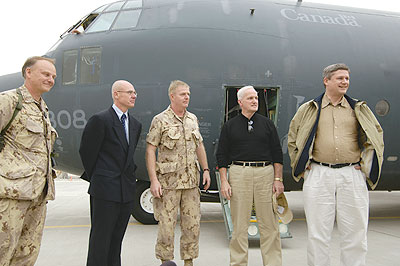
DND photo IS2006-1040
From the right, Prime Minister Stephen Harper, Minister of National Defence Gordon O’Connor, Chief of the Defence Staff (CDS) General Rick Hillier, Ambassador to Afghanistan Mr. David Sproule, and Commander Regional Command South, Brigadier-General David Fraser address the media at Kandahar airfield during the first official visit to Afghanistan by the Prime Minister and the Minister of National Defence, 12 March 2006.
Hillier’s vision aligned almost perfectly with that of the prime minister, as the new CDS was convinced that, for the CF to be able to achieve greater strategic effects for Canada, it needed to transform fundamentally into a force capable of operating from littoral areas and with focused land effects to address the challenges created by failed and failing states, where the CF was most likely to be engaged in the future.26 Martin and Minister of Defence Bill Graham gave Hillier unprecedented influence and control in the writing of a new defence policy statement, one that favoured the CDS’s policies, perspectives, force structure objectives, and procurement goals.27 Like Hellyer’s White Paper in 1964, the 2005 defence policy statement reflected Hillier’s outlook for a renewed CF.
Hillier’s ideas for defence were unique, innovative and bold for Canada and its military, and, in some ways, some of those ideas were intellectually similar to those espoused by Hellyer 40 years before, after factoring in the different international context of the two periods (see CF vision at Figure 1). The CDS offered the government a uniquely Canadian solution to the defence challenges posed by the post-9/11 international and continental environments, one focused on Canadian national interests. Hillier had presented the government with a comprehensive and integrated vision for Canada’s military. Canada’s military needed to be more focused and selective in their purposes, and expeditionary commitments needed to change to reflect the new realities. Instead of engaging in a series of small military commitments dispersed around the world, Hillier believed that a much greater impact for Canada could be achieved with the CF concentrating its military effort by contributing more robust capabilities to fewer operations, such as is currently the case with Canada’s contribution in Afghanistan – allowing the country to have its own area of operations within the theatre, a stronger voice at the strategic decision-making bodies, and more senior operational command appointments within the coalition, all of which are critical factors to wield influence and to ensure Canadian national interests are protected.
The capability and force structure changes (i.e., creation of Special Forces Operations Group, the development of an amphibious Standing Contingency Task Force, and the acquisition of medium- to heavy-lift helicopters) that Hillier proposed placed greater emphasis on developing a rapidly deployable CF integrated capability, much like Hellyer was thinking when he tasked the navy in 1963 to produce a fleet plan that would fit within his US Marine Corps-like concept for a new integrated CF and when he formed Mobile Command in 1965 – Canada’s first joint land-air command.29
Hillier’s vision and force structure changes were certainly contentious inside certain elements of the CF, as they seriously challenged the long-accepted balanced force concept by favouring a “land-centric” approach to future CF operations, and by putting more emphasis on all-arms capabilities to support land operations.30 In private, critics complained that the CDS was simply using his position to push through a vision that strongly favoured the army, restoring it as the dominant service of Canada’s military, with the navy and air force fulfilling supporting roles. On the other hand, the operational command reorganizations he instituted (four new operational commands and a strategic joint staff) were strongly supported, as these increased operational primacy and reinforced the CF unified chain of command, especially for the conduct of domestic, continental and international operations. Finally, much like Hellyer, who took personal charge of the unification agenda in 1964, the CDS, and not the Environmental Chiefs of Staff (ECSs), took charge of the implementation of the CF Transformation.
Unification was intended primarily to create a military establishment that would think and act from a national perspective. While Hellyer would likely be comforted by Hillier’s vision and initiatives, especially that a unified defence policy was being developed with Canadian national interests in mind, he would probably be concerned to discover that much of the 2005 defence policy had been thought out, developed and written by the CDS, and not by the Minister. In 1963, Hellyer definitely did not want the military to set defence policy. He sought a strong CDS to neutralize the influence of the three service chiefs, to centralize the administration and control of the CF, and to provide him and the government with coordinated and coherent policy advice on defence issues. He probably never envisaged that the office of the CDS created in August 1964 would become powerful to the point of being such a dominant force in the development of defence policy in Canada.
One Chief of the Defence Staff and one Unified Staff
The replacement of the positions of the Chairman of the Chiefs of Staff Committee, and chiefs of the naval staff, general staff, and air staff by a single new position designated as the Chief of the Defence Staff was, as Hellyer stated, “... the first and perhaps the most important move in the integration of the armed forces under a single defence staff.”31 It was the cornerstone of Hellyer’s unification plan, as this fundamental reform of the Canadian military structure in 1964 signalled a strong message of change and set in motion a series of important organizational changes that eventually would lead to the elimination of the services in February 1968.
The establishment of the office of the CDS was driven largely by political needs to address repeated weaknesses in the administration of defence policy and failures of the mechanisms for controlling and coordinating the activities of the armed forces. Hellyer was convinced that the reform of the top of the command structure, through a centralization of the control and administration of the CF into one CDS, the creation of one single, integrated defence staff, and the formation of a new Defence Council was the best way to overhaul the mechanisms of civil control of the Canadian military. The years 1957-1963 were a time of turmoil in Canada’s defence policy, and underlying all of Hellyer’s reforms was a pressing need by the government to strengthen civil control of the military in the aftermath of the turbulent Diefenbaker government years and the Cuban Missile Crisis of October 1962, when some believed that the services had responded unilaterally to their alliance commitments.32 “The CDS was the product of a political act to mend fissures in Canadian civil-military relations,” concluded Bland.33
The first restructuring step took place in August 1964 with the nomination of Air Chief Marshal Frank Miller as the first CDS, and it allowed Hellyer to rapidly centralize decision-making at Defence and take charge of all defence issues.34 With the creation of the office of the CDS came a reorganization of the defence staff through the integration of the three service headquarters into one CFHQ. Under the old system, the service chiefs each had direct access to the minister, giving them the opportunity to argue their case without any interference from their colleagues, and with their plan getting no vetting from a central staff. Only an integrated staff in one CF headquarters would ensure policy coherence, increase coordination, reduce waste and overhead costs, and realize greater administrative efficiencies in the end.35 Many of those aims were achieved with the creation of CFHQ in 1964.
The structure Hellyer created in the 1960s not only influenced the development of defence policy, but dynamically shaped the office of the CDS as the years passed. In 1964, Miller was still considered a staff coordinator, and it was General Jean-Victor Allard, an army officer and CDS during the period 1966-1969, who first asserted the authority of the office, functioning as a commander, and not as a coordinator.36 Early in his term as CDS, Allard also created Armed Forces Council (AFC), a senior advisory body comprising of the chiefs of the branches of CFHQ and the commanders of the functional commands, creating an essential forum for senior CF general and flag officers.37 After 1969, however, the authority that the office of the CDS had acquired began to erode, accelerated by the amalgamation of CFHQ with the departmental headquarters in the early 1970s, and the resurgence of the services in the 1980s and 1990s.38 With each reorganization of NDHQ and of the CF, the authority of the CDS changed.
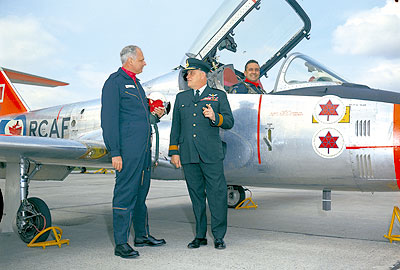
DND photo 287-IMG0025
Minister of National Defence Paul Hellyer, CDS General Jean Victor Allard, and a ‘spankin’ new’ CT-114 Canadair Tutor jet trainer
The 1970s and 1980s saw increased centralization and civilianization at Defence, a period when civilian public servants progressively performed more defence functions and gained more influence. The creation of NDHQ in 1972 did much to encourage the military and civilian staffs to work more closely and to increase coordination, but it also started a military-civilian integration trend and a culture shift inside Defence that would continue for nearly 30 years.39 Chiefs of Defence Staff complained that this new arrangement provided public servants “...a degree of authority over military affairs without responsibility for military accountability or performance,” which contributed to a “...clouding of the lines of responsibilities and accountability” inside the defence headquarters.40 By the early 1990s, the chain of command was distorted, and the NDHQ system had civilianized high command decision-making, limiting the ability to offer professional military advice. Gradually, military influence on CF operational matters eroded, resulting in a degradation of operational priorities in the headquarters, as strong deputy ministers interceded in the military chain of command and tended to dominate the CDS intellectually.41 This civilianization trend started to reverse however following the Somalia Inquiry and the release of the Report to the Prime Minister on the Leadership and Management of the Canadian Forces, both of which had made critical observations and recommendations on the CF chain of command and on the division of responsibilities inside NDHQ.42
Despite this continued civilianization of NDHQ, service chiefs had progressively reassumed some of the power and influence of the pre-unification era, especially after the return of the commanders of the commands to Armed Forces Council in the early 1980s. In 1988, Armed Forces Council rejected a proposal to strengthen the central staff and the role of NDHQ in times of emergencies and war.43 The decision was “...a defeat for unification,” lamented Bland, as it gave commanders of command near equal status with the CDS; more importantly, it elevated their commands and staffs to positions of authority in defence policy formulation.44 This strong-service trend continued in the 1990s with the relocation to Ottawa of the commanders of the army, navy, and air force and their staffs. An important devolution of authority to realign authorities and resources with responsibilities of the commanders, including giving control of large single operating budgets to the ECSs, further reinforced their influence and autonomy, and gave the three Chiefs of Staff near veto power over most key CF agenda issues.45 Those factors, combined with a lethargic governance structure at NDHQ, contributed to decision-making paralysis. But fundamental changes were to come with the arrival of Hillier as CDS, who immediately and energetically took charge of all military affairs.
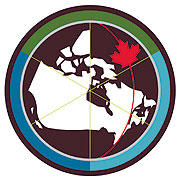 |
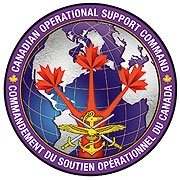 |
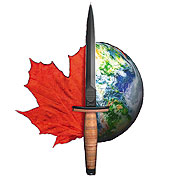 |
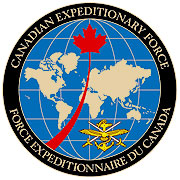 |
The central element of Hillier’s 2005 Transformation was operational primacy, and this included placing greater emphasis on operational matters in all decision- making at NDHQ. Hillier’s extensive operational experience, combined with Canada’s engagement in a high-intensity, high-risk military operation in southern Afghanistan, compelled him within a year of taking over as CDS to reform military governance at NDHQ, establishing a more robust unified staff to assist him in implementing the CF Transformation, in commanding the CF, and in providing advice to the government. In the late 1990s and early 2000s, a greater focus on “jointness” gave the Deputy Chief of the Defence Staff (DCDS) group an important unifying role, especially in areas of joint force development, joint doctrine and joint operations.46 Although a central unified staff existed inside the DCDS group to provide joint operational advice to the CDS, it was small and matrix-based, with limited full-time planning capability, and, consequently, it had limited authority and influence inside NDHQ.47 The force development and strategic planning staff inside the Vice-Chief of the Defence Staff (VCDS) group was weak as well, with the three environments often conducting force development activities independently.48
Many organizational changes inside NDHQ took place during the period 2005-2007, but three critical decisions by Hillier turned out to be essential to allow him to advance the CF vision. First, the CDS took charge of force development by strengthening the VCDS branch and by re-establishing a strong central unified Chief of Force Development to execute the four key lines of operations for the CF Transformation (vision, structure, capabilities, and people). He also created a Military Personnel Command, responsible to the CDS, and gave his new commander greater authority for all issues affecting CF personnel.49 The most significant change in military reorganization at NDHQ, however, has been the dismantling of the DCDS group and the establishment of a strong unified Strategic Joint Staff (SJS) reporting directly to him. While it can be argued that the SJS is not yet truly functioning at the military- strategic level, as originally envisaged by Hillier, it remains that in the two-and-a-half years since its establishment, the SJS has considerably changed the dynamics of decision-making in the operational realm, restoring military influence on issues affecting CF operations.50
Some critics argue, however, that the new SJS, Hillier’s commanding personality, and other key strategic governance changes that took place inside NDHQ during his term as CDS, have dangerously eroded the traditional balance between the civilian and military staff, and have led to the marginalization of the influence of senior bureaucrats inside Defence.51 Those fears are exaggerated. There remains in NDHQ a very strong deputy minister group to assist in the management of the armed forces, and to provide advice and support the minister. As the same time, however, the SJS ensures that the civil staffs do not assume functions that are within the purview of the military staffs, and that the CDS can effectively command the CF.52
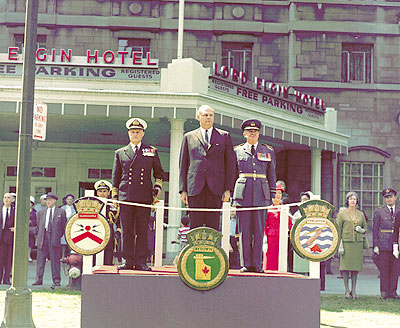
DND photo 151-IMG0003
Saluting dias in front of the Lord Elgin Hotel, Ottawa, Battle of Atlantic Sunday, 3 May 1964. Right to Left, Air Vice-Marshal V.S. Milland, MND Paul Hellyer, and Vice-Admiral H.S. Rayner.
In 1964, Hellyer wanted a CDS who would take all the service interests and needs, and bring forward to the minister and the government a coherent national perspective on defence issues. He also wanted a CDS with the authority to dominate and control the services. While the ECSs may have regained considerable power and authority over the CF agenda in the 1980s and 1990s, Hillier’s decisive leadership, dynamic personality, and unmatched public profile have eclipsed the three environmental chiefs in recent years, reversing a 30-year trend. Strong and visible support by the government for the CDS has also contributed significantly to prevent any possible criticism and dissention.
Hillier’s highly visible role in shaping defence policy, in articulating persuasively defence issues to the Canadian public, and in exercising his command of the CF has considerably strengthened the role of the office of the CDS. Today, the CDS’s power and authority inside the CF is unparalleled, and it is essentially unchallenged by the services and their constituencies. The establishment of a strong unified staff, a shift in the institutional power of the DM on operational matters, and the decreased influence of environmental commanders have prominently placed the CDS as the sole military advisor to the government, strengthening at the same time civil control of the military.53 The office of the CDS of 2008 is all that Hellyer wanted in 1964. More importantly, as Bland observes, over the 40 years since unification, Chiefs of the Defence Staff, including General Hillier, have “...exercised their rightful and implicit authority in a very nuanced and responsible way, mainly because they wholeheartedly support the principle that the civil authority must ultimately control and direct the Canadian Forces and Canada’s national defence.”54 In this sense, Hellyer’s vision has been more than fulfilled.
Editor’s Note: Part Two of this article will be published in the next edition of the Canadian Military Journal.
![]()
Notes
- Major-General Daniel Gosselin is the Commander of the Canadian Defence Academy. His most recent assignments included being Director General, International Security Policy in the Policy Group at NDHQ, Chief of Staff for the CF Transformation Team in 2005-06, and Commandant of the Canadian Forces College in Toronto. He holds advanced degrees in civil engineering, public administration, and war studies, and he is a part-time PhD candidate in the department of history at Queen’s University, working on his dissertation analyzing Canada’s national command.
- Canada, White Paper on Defence (Ottawa, 1964), in Douglas Bland, Canada’s National Defence Volume 1 Defence Policy (Kingston, Queen’s University, School of Policy Studies, 1997), p. 92.
- Bland, Ibid., p. 93. Bland’s works on the unification period and its consequences are: The Administration of Defence Policy in Canada: 1947 to 1985 (Kingston: Ronald P. Frye & Company, 1987), and Chiefs of Defence: Government and the Unified Command of the Canadian Armed Forces (Toronto: The Canadian Institute of Strategic Studies, 1995).
- Readers interested in the roots and causes of the crisis should consult my article: “The Storm over Unification of the Armed Forces: A Crisis of Civil-Military Relations,” in Howard Coombs, ed., The Insubordinate and the Noncompliant: Case Studies of Canadian Mutiny and Disobedience, 1920 to Present (Toronto: Dundurn Press, 2007), pp. 309-43, and R. B. Byers, “Canadian Civil-Military Relations and Reorganization of the Armed Forces: Whither Civilian Control?” in Hector J. Massey, ed., The Canadian Military: A Profile (Toronto: Copp Clark Publishing, 1972), pp. 197-228.
- The term “integration,” refers to the amalgamation of the headquarters, commands, and support establishments of the three services, while preserving the services themselves as separate institutions. “Unification” means the establishment of a single military service in place of the army, navy and air force, with full integration of all service functions. To Hellyer, unification was the end objective of a logical and evolutionary progression. Although integration and unification are sometimes regarded as alternatives, and inherently different, they are, in fact, merely different stages in the same process. Integration was actually the term applied to the first stages of unification of the Canadian Armed Forces. After 1972, however, the term integration also became more frequently used to refer to the restructuring of DND as a single entity, with the integration of the CF Headquarters (CFHQ) into NDHQ. Hellyer, “Address on the Canadian Forces Reorganization Act,” 7 December 1966, Debates, p. 10827.
- Three years ago, about nine months into the CF Transformation, with Dr Craig Stone, I wrote an article in this journal to explain the key differences between the unification of the CF and the transformation launched by General Hillier in February 2005, focusing primarily on the two implementation strategies. The current article focuses strictly on the legacy of those fundamental ideas that Hellyer brought to Defence in 1963, and does not address the implementation strategy he followed. For those interested, see, “From Minister Hellyer to General Hillier,” Canadian Military Journal, Vol. 6, No. 4 (Winter 2005-2006), pp. 5-15.
- The “address on the Canadian Forces Reorganization Act” is the nearly two-hour speech Hellyer gave on moving second reading on Bill C-243 in the House of Commons on 7 December 1966. It is certainly the best written record of Hellyer’s arguments for unification. See Debates, pp. 10817-47. Hellyer also offered his views in answer to questions both in the House of Commons and during several defence parliamentary committees, and he published an article “Canadian Defence Policy” in the U.S. Air University Review (Vol. 19, No. 1, November/December 1967). Hellyer’s memoirs on unification, Damn the Torpedoes: My Fight to Unify the Canadian Forces (Toronto: McClelland & Stewart, 1990) are also valuable, despite being written over 20 years after he left Defence.
- While it is understood that, by law, there is only one service in Canada, the Canadian Armed Forces, and three environments, the term service is used in this article to refer specifically to the traditional core Army, Air Force and Navy components of the CF. The term Chiefs of Staff is used alternatively throughout to mean the service chiefs of staff or the environmental chiefs of staff (ECS) depending on the context of the discussion presented.
- This expression is from James Eayrs’ fourth volume of his series In Defence of Canada: Growing Up Allied (Toronto: University of Toronto Press, 1980). NORAD eventually was renamed the North American Aerospace Defence Command.
- For a more comprehensive discussion, see in particular Bland, Administration of Defence Policy, pp. 33-55, and Chiefs of Defence, pp. 63-71.
- Bland, Canada’s National Defence Volume 1, p. 59; Hellyer, Damn the Torpedoes, p. 33; and Air Marshal F.R. Sharp, Minutes of Proceedings and Evidence, presentation to the Standing Committee on National Defence, 7 February 1967, p. 452.
- Hellyer, Damn the Torpedoes, p. 34, and J.L. Granatstein, “Unification: The Politics of the Armed Forces,” in Canada 1957-1967: The Years of Uncertainty and Innovation (Toronto: McClelland and Stewart, 1986), p. 223.
- White Paper, in Bland, Canada’s National Defence Volume 1, p. 83.
- Granatstein, “Unification,” p. 225. There can be significant confusion in the terminology employed, especially when comparing writings and speeches between 1963 and 2008. “Integrated” to Hellyer meant the merging of two or more service (army, air force and navy) functions into one (as in integrated HQ or integrated forces), which is also termed “joint” in the context of today’s operational doctrine. Hellyer did not employ the term “joint” (which came later), but instead used “combined” to describe operations of more than one service.
- Bland, Canada’s National Defence Volume 1, p. 60.
- Bland, Chiefs of Defence, pp. 87-8.
- For a detailed discussion on the tug of war between unification and the strong-service idea, see my article “Unification and the Strong-Service Idea: A 50-Year Tug of War of Concepts at Crossroads,” in Allan English et al., eds., Operational Art: Canadian Perspectives – Context and Concepts (Kingston: Canadian Defence Academy, 2005). The best discussion on service personalities, identities and behaviour remains the study by Carl H. Builder, The Masks of War (Baltimore: Johns Hopkins University Press, 1989), pp. 1-45.
- On the lack of political leadership, see General G.C.E. Thériault, “Reflections on Canadian Defence Policy and its Underlying Structural Problems,” Canadian Defence Quarterly (July 1993), p. 8. On lack of military leadership, see Douglas Bland, “Canada’s Officer Corps: New Times, New Ideas,” presentation to the CDA Institute 15th Annual Seminar (Ottawa, 1999), n. pag., at <http://www.cda-cdai.ca/seminars/1999/99bland.htm>, accessed 15 August 2008.
- Douglas Bland and Sean Maloney, Campaigns for International Security (Kingston: School of Policy Studies, Queen’s University, 2004), p. 82.
- Bland, Chiefs of Defence, p. 158.
- A powerful group, called Canada Council 21, strongly advocated that the CF should be equipped to conduct peacekeeping, the delivery of humanitarian aid, the protection of Canadian sovereignty, and the provision of aid to civil power. The evolution of Canada’s defence policy is best explained in Brian W. Tomlin, Normal Hillmer and Fen Osler Hampson, Canada’s International Policies: Agendas, Alternatives and Politics (Toronto: Oxford University press, 2008), pp. 132-54.
- See Bland, Chiefs of Defence, for a more complete discussion on this issue, pp. 268-72.
- Hillier’s influence on defence policy was being written while he was still in office. See notably, Tomlin, Hillmer and Hampson, Canada’s International Policies, p. 131 and pp. 150-4; Janice Gross Stein and Eugene Lang, The Unexpected War: Canada in Kandahar (Toronto: Penguin, 2007), pp. 146-51; and Stein and Lang, “Too Few Hilliers,” Walrus (April 2008), pp. 34-9.
- Stein and Lang, Unexpected War, pp. 147-8. General Hillier had articulated those ideas in a letter written when he was Chief of the Land Staff in 2003, “Strategic Capability Investment Plan – Land Effect,” letter 3136-5 (CLS), dated 26 June 2003. This memo is also discussed in Stein and Lang, “Too Few Hilliers,” p. 34.
- Paul Martin’s vision was first enunciated in a document titled Making History: The Politics of Achievement published in anticipation of the November 2003 Liberal Party leadership convention, reinforced by his 14 April 2004 address at CFB Gagetown. See Kevin Cox, “Martin boosts defence spending,” Globe and Mail, 15 April 2004, p. A4. On the absence of specific direction, see Douglas Bland, “Hillier and the New Generation of Generals: the CDS, the Policy and the Troops,” Policy Options (March 2008), p. 58.
- Canada, A Role of Pride and Influence in the World: Defence (Ottawa, 2005), especially pp. 7-13, and the CDS Transformation brief, “The Way Ahead for the Canadian Forces,” (Ottawa, National Defence HQ, 2005).
- Tomlin, Hillmer and Hampson, Canada’s International Policies, p. 151-2, and Stein and Lang, Unexpected War, p. 149-51.
- “The Way Ahead for the Canadian Forces,” ibid, slide 27 of 32.
- In the aftermath of the cancellation of the General Purpose Frigate programme in 1963, Hellyer had tasked the navy to produce a new fleet plan. Marc Milner, “Hard Lying, 1964-1968,” Canada’s Navy: The First Century (Toronto: University of Toronto Press, 1999), p. 244.
- For instance, the medium- to heavy-lift helicopters, the amphibious ship(s) to transport the SCTF, the growth of Special Forces, and the acquisition of additional CC-130s for tactical operations.
- Hellyer, Debates, 8 May 1964, p. 3065.
- For more details, see Jon McLin, Canada’s Changing Defence Policy 1957-1963: The Problem of a Middle Power in Alliance (Baltimore: Johns Hopkins University Press, 1967); J.L. Granatstein, “The Defence Débâcle, 1957-1963,” in Canada 1957-1967, pp. 101-38; and on the Cuban missile crisis, the best analysis remains Peter T. Haydon, The 1962 Cuban Missile Crisis: Canadian Involvement Reconsidered (Toronto: The Canadian Institute of Strategic Studies, 1993).
- Bland, Chief of Defence, p. 64.
- Debates, 8 May 1964, p. 3065. The White Paper had, curiously, made no mention of the issue of civil control per se, but it was clear that Bill C-90 was about civil control of the military, a theme the minister repeated constantly when questioned in the House of Commons in 1964.
- Hellyer, Damn the Torpedoes, pp. 33-34.
- Bland, Chiefs of Defence, p. 87 and pp. 167-8.
- Jean V. Allard, The Memoirs of General Jean V. Allard, with Serge Bernier (Vancouver: UBC Press, 1988), p. 256.
- Bland, p. 92.
- Ibid., pp. 80-121 and pp. 161-5.
- Admiral Falls, quoted in Bland, Ibid., pp. 161-2; Gerry Thériault, “Democratic Civil-Military Relations: A Canadian View,” in Jim Hanson and Susan McNish, eds., The Military in Modern Democratic Society (Toronto: The Canadian Institute of Strategic Studies, 1996), pp. 9-10.
- David Bercuson, Significant Incident (Toronto: McClelland and Stewart, 1996), p. 74. On the DM and the CDS, see Jack Granatstein, Who Killed the Canadian Military? (Toronto: HarperCollins, 2004), pp. 86-90; and Bland, “Canada’s Officer Corps.” Also, on the loss of ethos and military values, see Peter C. Kasurak, “Civilianization and the Military Ethos: Civil-Military Relations in Canada,” Canadian Public Administration, Vol. 25, No. 1 (Spring 1982), pp. 108-129.
- Douglas Young, Report to the Prime Minister on the Leadership and Management of the Canadian Forces, 25 March 1997, available at: <http://www.forces.gc.ca/site/minister/eng/pm/mnd60.html>, accessed 15 August 2008.
- The study was officially NDHQ Study S1/88, The Functions and Organization of National Defence Headquarters in Emergencies and War, named after its authors, Major-General W.E. Little and D.P. Hunter, a public servant. A copy of the report of the study is available in Bland, Canada’s National Defence Volume 2, pp. 417-509.
- Bland, Chiefs of Defence, pp. 191-7.
- Granatstein, Who Killed Canada’s Military?, pp. 92-3, and Gosselin, “Unification and the Strong-Service Idea,” pp. 168-71.
- For a discussion on “jointness” in the CF, see G.E. Sharpe and Allan D. English, Principles for Change in the Post-Cold War Command and Control of the Canadian Forces (Kingston: Canadian Forces Leadership Institute, 2002), pp. 47-50, and Gosselin, “Unification and the Strong-Service Idea,” pp. 172-7.
- The matrix-based staff meant that a majority of the staff was double-hatted, with a regular staff function at NDHQ, often with responsibilities not closely related to operations. When a CF operation was being planned or initiated, the matrix staff would then perform their secondary role of supporting the DCDS.
- In this regard, see the current Chief of Force Development website, at <http://www.cfd-cdf.forces.gc.ca/sites/page-eng.asp?page=5180>, accessed 15 August 2008. CFD had been eliminated in the mid-1990s, and the functions amalgamated under the position of Director General Strategic Planning.
- Military Personnel Command replaced the Assistant Deputy Minister (Human Resources – Military) making it clear that the development and application of personnel policies for CF members were more a responsibility of the CDS than of the DM.
- In 1995, Bland had predicted this possibility. “If the CDS had under his sole control a strong unified staff, a Canadian Forces Headquarters..., where military authority could be concentrated and if he could count on his subordinate commanders to act as allies, then ‘civilianization’ rule by public servants, the phenomenon so dreaded by the military, would hardly have any chance to prosper.” Chiefs of Defence, p. 171.
- Lawrence Martin, “In Defence, the civilian side is on the slide,” The Globe and Mail, 7 September 2006, A21. Stein and Lang also discuss this theme in “Too Few Hilliers,” pp. 37-8.
- Ironically, Hellyer had issued a warning on this specific issue in the House of Commons in 1964, stating that, “In seeking to build a strong civil staff to assist the minister in the control and management of the armed forces, I have clearly in mind the need at the same time for exercising care that the civil staffs do not assume functions which are necessary to the military staffs in order that they can effectively control their military forces and carry out their military responsibilities.” Hellyer, Debates, 8 May 1964, p. 3068.
- I refer here to the loose criteria outlined by Bland in his book Chiefs of Defence, p. 171.
- Bland, “Hillier and the New Generation of Generals,” Options (March 2008), p. 56.
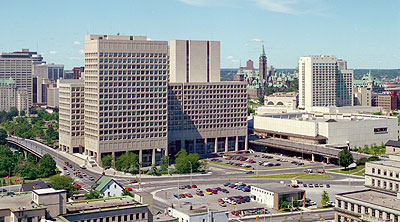
DND Photo ISC87-380
National Defence Headquarters, 101 Colonel By Drive, Ottawa.







